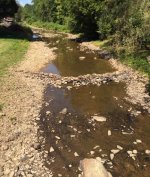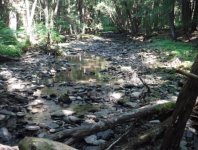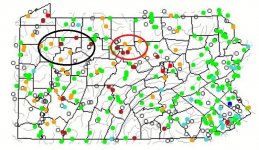Prospector
Well-known member
It's no secret that streams are low, but I thought I would share some photos I took over the weekend. I headed to camp in Forest Co to do some work and snuck out for an hour to check a stream for trout. I purposely chose a stream where I was not sure if it had any wild trout. I would fish until I caught a trout and then consider the mission a success and immediately quit. This was not a pleasure trip but instead an information gathering trip.
I crossed East Hickory Creek and it was so low I snapped a photo off the RT 666 bridge looking upstream (see photo). I got to the trib I wanted to fish. Water temp came back at 60 degrees but the flow was terrible (see photo). I decided to stick with my plan due to the water temp but it was really difficult to find a hole. Many areas, like in the photo, were virtually impossible for fish to travel from a shrinking pool to a pool that offered some protection.
The end result was I landed five 4 inch minnows and a shiner. No sign of a trout. The flow was so slow it was difficult to find a surface bubble. Is it safe to assume that the lack of dissolved oxygen could have killed trout that had been in this stream in May? Do large minnows and shiners require less dissolved oxygen than trout, thus allowing them to carry on when trout cannot? The water temperature itself was no problem at all.
I also attached a photo of the USGS stream flow conditions from today. The area I circled in BLACK is the general area where these streams reside and all small streams are dangerously low. The 2 green dots in that circle are from gauges on the Allegheny River, which of course is water released from a dam. All other streams are a trickle. I also circled the streams RED in Potter/Clinton Co stretching from the First Fork to Kettle to Young Womans Creek. I'm concerned about the small tribs in that area too if my "lack of dissolved oxygen" theory is a real and valid concern.
Any thoughts from those of you with a much better knowledge of the science behind cold temp, low flows and dissolved oxygen?
I don't know the science so my only measuring stick for this was in June 10 2016 when I caught 53 Brook trout and 7 browns from a trib to Kettle (all small wild fish). The next year on June 9th I fished the same stretch of that same trib and caught 14 brook and 10 browns. What happened after my nice catch? A drought and high temps ensued throughout the summer to the point that on Aug 27 2016 the cfs fell to 12. Today Aug 25 2020 the Kettle cfs is 10 (25th percentile is 13). The all time low on this date was 1971 when it hit 2.9. I can't even fathom that.
Thanks for your thoughts!!
I crossed East Hickory Creek and it was so low I snapped a photo off the RT 666 bridge looking upstream (see photo). I got to the trib I wanted to fish. Water temp came back at 60 degrees but the flow was terrible (see photo). I decided to stick with my plan due to the water temp but it was really difficult to find a hole. Many areas, like in the photo, were virtually impossible for fish to travel from a shrinking pool to a pool that offered some protection.
The end result was I landed five 4 inch minnows and a shiner. No sign of a trout. The flow was so slow it was difficult to find a surface bubble. Is it safe to assume that the lack of dissolved oxygen could have killed trout that had been in this stream in May? Do large minnows and shiners require less dissolved oxygen than trout, thus allowing them to carry on when trout cannot? The water temperature itself was no problem at all.
I also attached a photo of the USGS stream flow conditions from today. The area I circled in BLACK is the general area where these streams reside and all small streams are dangerously low. The 2 green dots in that circle are from gauges on the Allegheny River, which of course is water released from a dam. All other streams are a trickle. I also circled the streams RED in Potter/Clinton Co stretching from the First Fork to Kettle to Young Womans Creek. I'm concerned about the small tribs in that area too if my "lack of dissolved oxygen" theory is a real and valid concern.
Any thoughts from those of you with a much better knowledge of the science behind cold temp, low flows and dissolved oxygen?
I don't know the science so my only measuring stick for this was in June 10 2016 when I caught 53 Brook trout and 7 browns from a trib to Kettle (all small wild fish). The next year on June 9th I fished the same stretch of that same trib and caught 14 brook and 10 browns. What happened after my nice catch? A drought and high temps ensued throughout the summer to the point that on Aug 27 2016 the cfs fell to 12. Today Aug 25 2020 the Kettle cfs is 10 (25th percentile is 13). The all time low on this date was 1971 when it hit 2.9. I can't even fathom that.
Thanks for your thoughts!!






